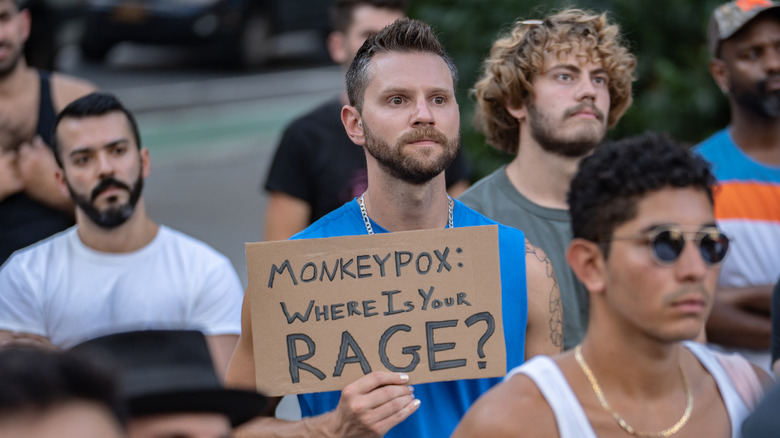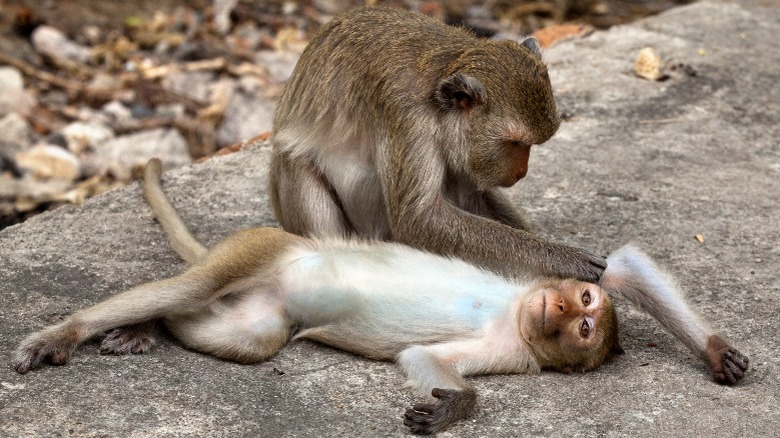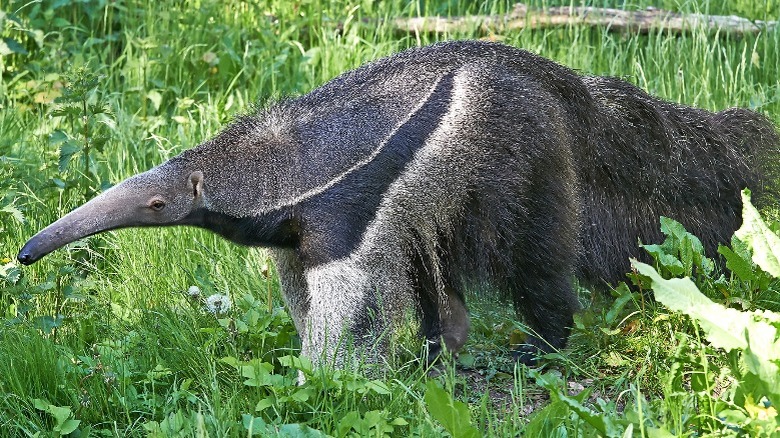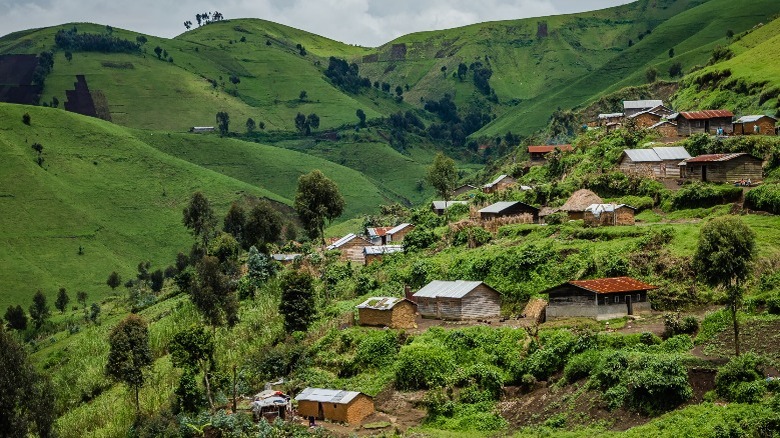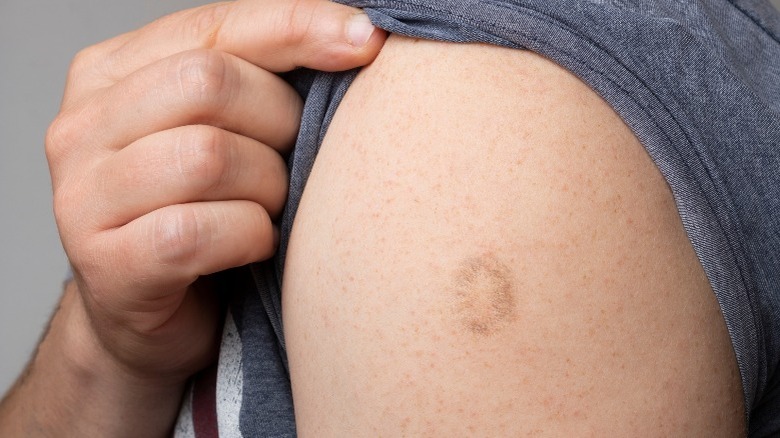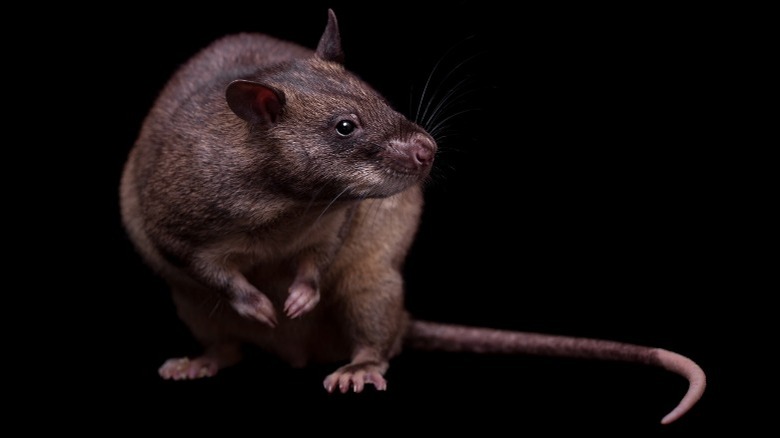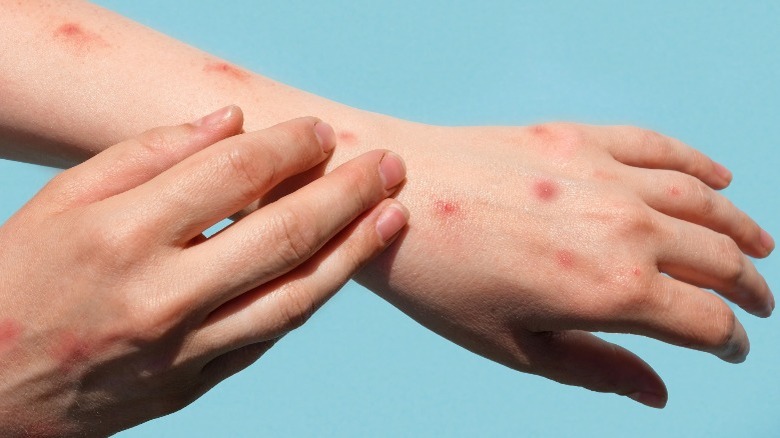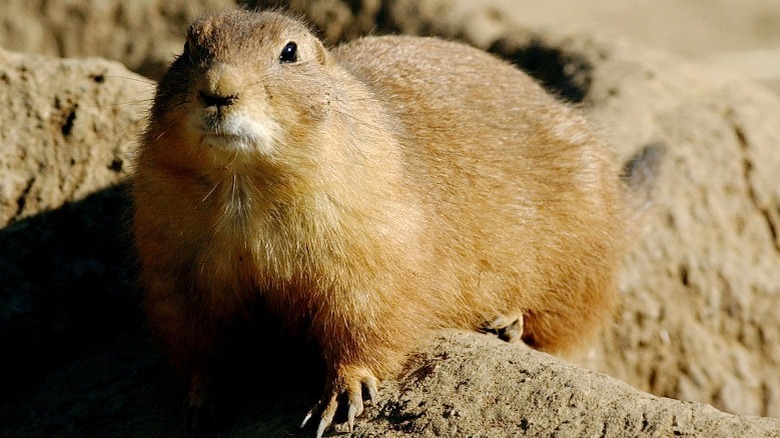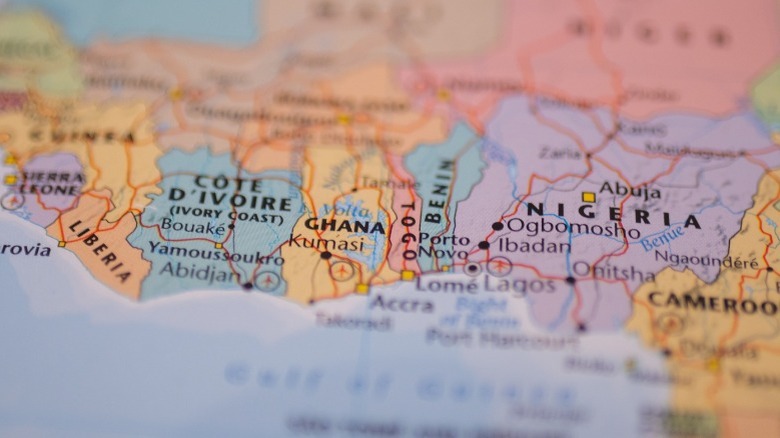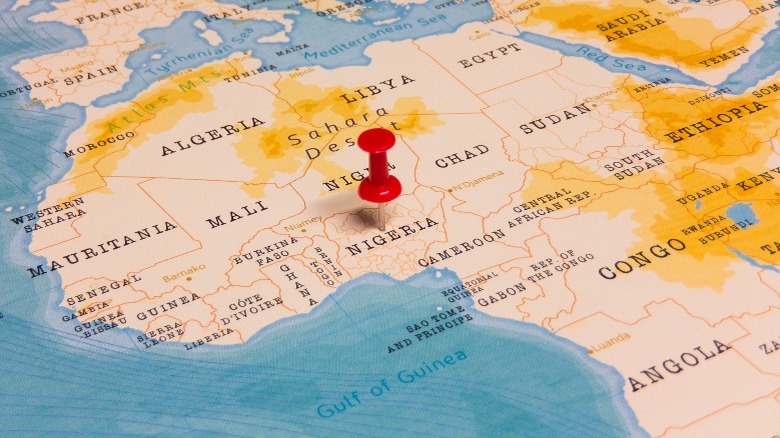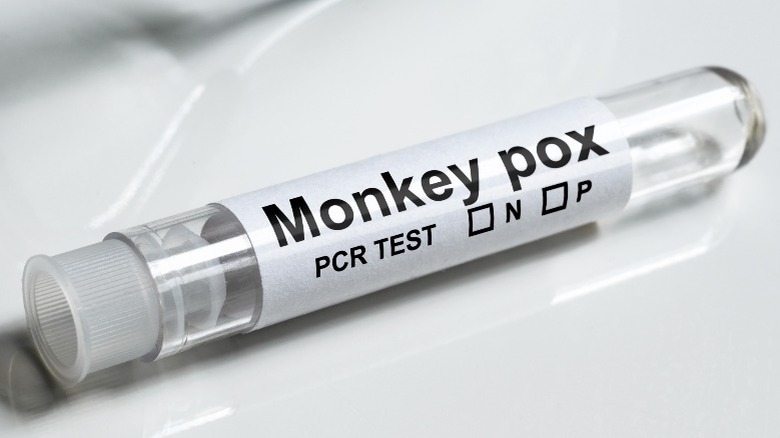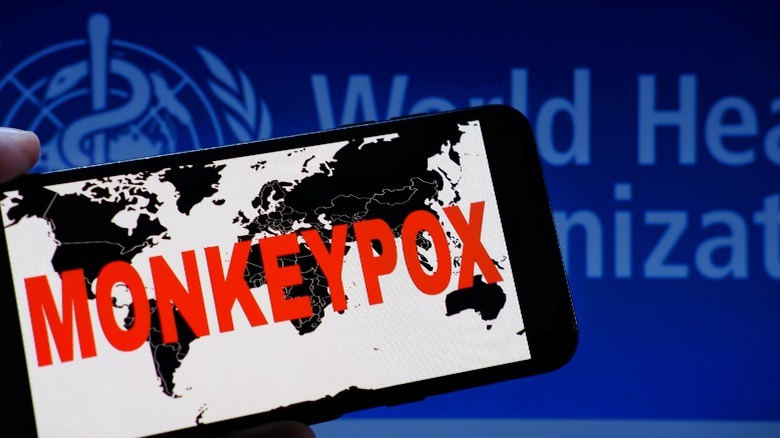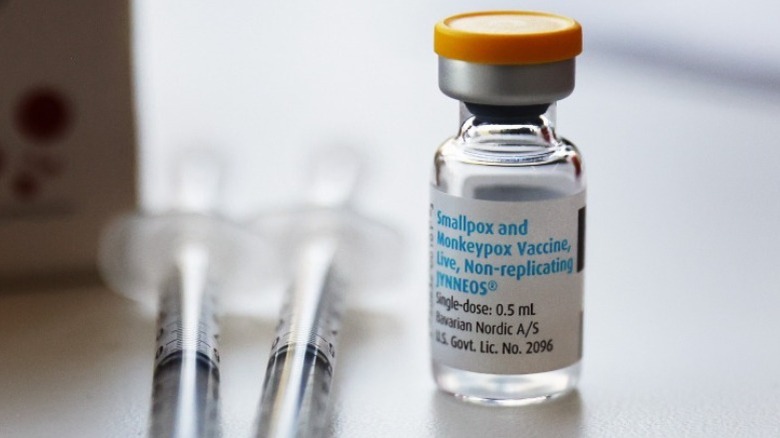The History Of Monkeypox Explained
In 2022, monkeypox became the latest continent-jumping illness taking the world by storm. A cousin of the Variola virus responsible for smallpox (per Britannica), the monkeypox virus causes milder – but still pretty unsettling – symptoms. According to the Centers for Disease Control and Prevention (CDC), monkeypox typically presents as a rash on or near the genitals or on the hands, feet, chest, face, or mouth, alongside other symptoms like fever, muscle aches, and swollen lymph nodes. The illness develops about three weeks after exposure and lasts two to four weeks.
As with most viruses, symptoms are highly variable, making monkeypox challenging to diagnose. As the CDC explains, it spreads mainly through skin-to-skin touching, exposure to the saliva of an infected person, and contact with items a sick person has handled, such as bedding and towels. According to CDC official Dr. Demetre Daskalakis (via CNN), monkeypox is not considered a sexually transmitted disease, but sexual activities definitely facilitate exposure. And, while the disease is currently most prevalent in men who have sex with men (per the World Health Organization), it's important to note that anyone can contract monkeypox.
Endemic to western and central Africa (per the WHO), monkeypox has become a global phenomenon. But exactly how did this happen? From its initial discovery in lab monkeys to a massive explosion of cases in Nigeria to a global outbreak in 2022 deemed a public health emergency, here is the history of monkeypox explained.
Monkeypox was discovered in captive monkeys in 1958
According to a 2013 study published in Future Virology, in the mid-20th century, a lab in Denmark used monkeys for its polio vaccine research. And, in 1958, several of the lab's long-tailed macaques (pictured) fell ill with a mysterious disease.
Researchers noted that the illness featured large pustules that covered most of the monkeys' bodies, but the animals were otherwise healthy, and the lesions healed. Following a second outbreak, samples were analyzed. The results revealed a previously unseen virus of the genus Orthopoxvirus – the same genus that contains smallpox. It was given the name monkeypox. As a 1968 study published in the Bulletin of the World Health Organization notes, none of the infected monkeys died, and none of the people who handled the monkeys became sick.
According to Frank Fenner in his book "The Orthopoxviruses," the WHO began investigating facilities that housed monkeys out of concern that the closely-related virus would complicate efforts underway to eradicate smallpox. Between 1958 and 1968, a total of nine outbreaks were identified in European and American labs, with monkeypox being the confirmed culprit in six. Per Fenner, most of the infected monkeys had been received from Asia. However, testing revealed that the monkeypox virus was not found in Asian monkey populations. Asia was simply a hub for animal transport – the virus could have come from anywhere.
An outbreak at a Dutch zoo in 1964
In December 1964, a mysterious tragedy befell the Rotterdam Zoo in the Netherlands. According to a study in Future Virology, the zoo had recently received two South American giant anteaters (pictured). Less than two weeks after their arrival, the anteaters became sick with an illness featuring skin lesions and were culled. Testing revealed that the animals had somehow contracted monkeypox. And, unfortunately, the damage was already done.
The anteaters' enclosure bordered the primate habitat, and the disease had spread to the Asian orangutans. The apes fell horribly ill, presenting skin redness, nasal discharge, and body sores. Six out of the 10 infected orangutans died within days. To make matters worse, they shared an enclosure with several other primates, which also contracted the illness (per Frank Fenner in his book "The Orthopoxviruses").
The zoo's African gorillas, chimpanzees, Asian gibbon, South American squirrel monkeys, African owl-faced monkeys, and South American common marmoset all fell ill with monkeypox. Per a 1968 study published in the Bulletin of the World Health Organization, a total of 23 animals were infected, and of these, 11 died. Still, according to Mary G. Reynolds and Damon K. Inger in their book "International Encyclopedia of Public Health," no exposed humans caught the disease – although the incident demonstrated that monkeypox was capable of infecting animals besides monkeys.
A baby was the first human to contract monkeypox in 1970
The game changed forever when monkeypox started infecting humans. According to a 2018 study in Frontiers of Public Health, a 9-month-old baby from Bokenda – a remote village in what is now the Democratic Republic of the Congo in central Africa – was hospitalized with symptoms resembling smallpox in August 1970. Testing revealed that the infant was, in fact, suffering from monkeypox.
More human cases followed. According to a 1973 study in Bacteriology Review, four children under 10 tested positive for monkeypox in Liberia in 1970. A sixth case was identified in Sierra Leone that same year – this time in a 24-year-old man who had recently handled monkey guts. As the study observed, none of the infected people died of the disease, and no one exposed to the sick individuals contracted it. The study also noted that none of the infected individuals had been vaccinated for smallpox, and it explained the link between the affected humans and monkeys, which lived near the villages and were frequently eaten.
Overall, per the 2018 study, the WHO reported 59 cases of human monkeypox from 1970 to 1980. According to a 1980 study in the Bulletin of the World Health Organization, most cases occurred in children living in the Democratic Republic of the Congo. Several monkeys living in Liberia and Sierra Leone – where some human cases were observed – tested positive for monkeypox virus antibodies, meaning they had contracted (and carried) the disease at some point.
Smallpox was eradicated in 1980 – enter its cousin, monkeypox
Smallpox – the human-adapted cousin of monkeypox – plagued humanity for centuries (per Britannica). With its higher death and transmission rates, the Variola virus was way worse than the monkeypox virus is proving to be so far. Luckily, according to a 2020 study published in Vaccine, the WHO declared the disease eradicated in 1980, following an aggressive worldwide vaccination effort.
With smallpox gone, there was little need to continue inflicting its notoriously painful vaccine – which, per WedMD, involved repeatedly pricking the skin with a two-pronged needle that left a large scar – on humankind. Routine smallpox vaccines became a thing of the past, a cause of much rejoicing for humanity. But, as it turns out, the smallpox vaccine also provided protection from other orthopoxviruses, including the one that causes monkeypox.
As the 2020 study notes, around 70% of the current global population has not been vaccinated for smallpox. As a result, herd immunity to the eradicated virus – and therefore also its cousin – is disappearing. Simply put, the monkeypox virus stepped in to fill the role left vacant by the smallpox virus 40 years ago, and our immune systems are not prepared to fight it.
African outbreaks in the 1980s were linked to contact with animals
Once the monkeypox virus started taking hold in human hosts, it did not let up. According to a 2002 study in the Journal of Clinical Microbiology, there were 338 cases of human monkeypox in the Democratic Republic of the Congo from 1981 to 1986, with 33 of these ending in death. While the disease spread from person to person in some cases – notably when the individuals involved were not vaccinated for smallpox – an overwhelming 72% of cases could be traced back to direct contact with an animal.
Researchers had long suspected – based on the virus' discovery in macaques, the outbreak in the Rotterdam Zoo's primates, and the prevalence of wild monkeys near affected African villages – that monkeys played a role in the virus's transmission. Indeed, the 2002 study confirmed that handling dead monkeys and eating monkey meat was responsible for many monkeypox cases in Africa. But, as it turned out, monkeys weren't the only animals involved in the virus's transmission.
According to a 1987 study in Tropical and Biogeographical Medicine, scientists focused on African rodents, squirrels, and colony-roosting bats – not monkeys – as the most likely reservoirs – that is, animals responsible for keeping the virus in circulation (per the CDC). Studies in the 1980s identified squirrels as the most probable vectors, as they frequently lived near humans, and Medscape later named ground squirrels and other rodents as the virus's main hosts. Monkeys, it seemed, were only incidental hosts of the virus – just like humans.
Person-to-person spread increased in the 1990s
An outbreak in what is now central Africa's Democratic Republic of the Congo in the late 1990s showed a dangerous new side of the monkeypox virus. According to a 2020 study published in Vaccine, an outbreak that started in Katako-Kombe in February 1996 proceeded to infect 89 people over the course of a year in what, at the time, was the most major outbreak of the disease to date.
Unlike previous monkeypox outbreaks, the majority of cases – a whopping 73% per the 2020 study – were contracted by exposure to an infected person. Contact with wild animals only made up 27% of all cases. Simply put, the virus had grown more contagious to humans – a single sick person could now infect up to seven other individuals. Luckily, the symptoms of the disease were overall milder than in previous cases but, per a 2018 study published in Frontiers of Public Health, six people still died in the outbreak.
Prairie dogs caused an outbreak in the United States in 2003
The most bizarre twist in the monkeypox saga happened in the United States. According to a 2004 study in Seminars in Pediatric Infectious Diseases, a Wisconsin family purchased two pet prairie dogs at a swap meet on May 11, 2003. Two days later, one of the prairie dogs fell ill with skin lesions and bit the family's 3-year-old daughter. It died one week later. Shortly after being bitten, the little girl developed a fever and rash and was hospitalized. Days later, per Medscape, the whole family was sick. And it didn't end there.
Reports of pox-like symptoms started popping up throughout the Midwest. According to the CDC, 47 cases of monkeypox were confirmed in Wisconsin, Illinois, Indiana, Kansas, Missouri, and Ohio. Per Medscape, most infected individuals had had direct contact with captive prairie dogs. How did a rodent species native to North America end up carrying a virus endemic to Africa?
The CDC traced all infected prairie dogs back to one pet store in Illinois. The store had received several animals from a distributor in Texas, which had recently imported around 800 small mammals from West Africa. Testing revealed that several of these animals carried the monkeypox virus. Per the 2004 study, the prairie dogs had been housed alongside Gambian giant pouched rats from the shipment. They caught the virus from the African rats, then spread it to humans (and, in one case, per Medscape, a rabbit). Luckily, no additional cases were reported after June 22, 2003.
Two different clades of monkeypox were identified
Following the 2003 U.S. outbreak – the first time monkeypox had been seen outside of Africa (per the CDC) – researchers began investigating the virus in earnest. It wasn't long before two distinct genetic clades – or, per News Medical, geographically-separated lineages – of the virus were discovered. According to a 2005 study in the Journal of General Virology, scientists analyzed samples of the virus from the U.S., West Africa, and Central Africa – everywhere it was known to occur – and used genetics to develop a picture of its evolutionary history.
They discovered that the monkeypox virus seen in the U.S. perfectly matched the genome of the original virus observed in West Africa. This made sense, as the Gambian giant pouched rats responsible for the U.S. outbreak were originally from Ghana. As a 2018 study published in Emerging Infectious Diseases noted, the West African clade causes milder symptoms, does not spread easily between humans, and results in fewer deaths.
However, the 2005 study also discovered that there was a second lineage. According to a 2018 study published in Frontiers of Public Health, this version of the virus, known as the Central African or Congo Basin clade, spreads readily from person to person and kills more of the people it infects. Unfortunately, the 2018 study also observed that the Congo Basin clade was the most prevalent of the two – at least initially.
A 2017 monkeypox outbreak started in Nigeria and is still not contained
While it was quickly contained in the U.S., monkeypox remains an ongoing issue in western and central Africa. According to a 2019 study published in The Lancet, the disease unexpectedly returned to Nigeria in September 2017 – 39 years after the country's last case. It would go on to become the biggest outbreak of monkeypox yet, with 122 cases and seven deaths in the first year alone.
To make matters worse, the virus was spreading easily from person to person and killing its victims at a rate of 6% – yet tests revealed that the West African clade was responsible for the outbreak. This was alarming. As a 2018 study published in Frontiers of Public Health observed, previously, the West African clade of the virus typically did not spread between people and had a fatality rate of less than 1%. The West African clade had changed to become both more infectious and more deadly. It had also changed in other ways.
According to Dr. Dimie Ogoina, an infectious disease specialist in Nigeria (via NPR), more cases were occurring in young men in their 20s and 30s, whereas the disease had previously mostly affected children. He also observed that genital rashes were more common and that they often affected men who had numerous sexual partners. What's worse, Dr. Ogoina also claimed that the outbreak never went away, health officials just stopped surveying after 2017. Per STAT, the Nigerian monkeypox outbreak is still not under control.
Monkeypox escaped Nigeria in 2018
With an outbreak spiraling out of control in West Africa, it was only a matter of time before the inevitable happened. And, in September 2018, it did. According to a 2018 study published in EuroSurveillance, a Nigerian naval officer traveled to England to attend a training course. He brought with him – by way of a mysterious rash on his groin – a certain orthopoxvirus. Tests soon confirmed that the United Kingdom had seen its very first case of monkeypox. Two more followed: a U.K. resident who had traveled to Nigeria and, per The Guardian, the medical worker who assisted the sick traveler.
And the reports didn't stop coming. In December 2019, per GOV.UK, a fourth person was diagnosed with monkeypox in the U.K. after visiting Nigeria. And, in May 2019, a man who had likely eaten bushmeat at a Nigerian wedding was diagnosed with monkeypox in Singapore (per CIDRAP).
Reports of monkeypox outside of Africa continued into 2021. According to Public Health Scotland, a person who had lived in Nigeria returned home to North Wales in May 2021, became sick, and infected a family member. Both were diagnosed with monkeypox. In June 2021, per a 2022 study published in Infectious Disease Alert, an American man fell ill while traveling in Africa. He returned home to Dallas, Texas, where his condition worsened, and he was later hospitalized. Tests revealed that he had contracted the West African clade of the monkeypox virus in an urban area of Nigeria – evidence of a much larger problem.
The severity of the Nigerian outbreak was masked by COVID-19
In addition to Dr. Dimie Ogoina's claim (via NPR) that health officials stopped collecting data on the Nigerian outbreak after 2017, another – arguably greater – health issue complicated matters: a certain novel Coronavirus. According to News Medical, Nigeria saw its first case of COVID-19 in March 2020, and from that day on, what little energy was being put toward monkeypox shifted to curbing the spread of COVID-19. People suffering from monkeypox likely avoided hospitals out of fear of contracting COVID-19, meaning fewer cases were recorded. As Nigerian virologist Dr. Oyewale Tomori explained (via The Conversation) in 2021, many diseases – including Lassa fever and monkeypox – were under-reported as a result of COVID-19.
And there is another more insidious reason for the lack of data. According to a 2018 study published in Frontiers of Public Health, other diseases with the potential to cause epidemics – notably Ebola and Zika – have been largely ignored by the scientific community because they occur in the Southern Hemisphere. The study noted that monkeypox was similarly neglected in the scientific literature – that is until it broke out of Nigeria and started impacting developed countries like the U.K. and the U.S. As a result, we know very little about the virus, yet it is fast becoming everybody's problem. As Dr. Tomori told Smithsonian Magazine, "The world is a small place. This is not an African thing; it could happen anywhere."
Monkeypox went global in 2022
Much to the surprise of the wider world – but not to the Nigerian medical community – monkeypox became a global issue in the summer of 2022. According to the WHO, the first case was reported in the U.K. on May 7, 2022 – another traveler returning from Nigeria. Confident the disease had been contained through contact tracing as had been done effectively in previous years, the WHO declared it a minimal risk to public safety. But this time around, monkeypox had other plans.
Per the BBC, just days later, on May 12, two more people were diagnosed with monkeypox in the U.K. Curiously, these two individuals had no connection to the May 7 case and had not recently traveled to Nigeria. According to JAMA Network, following four more unconnected cases, health officials acknowledged that something they had long feared was happening: the virus was spreading through the community without a known source.
By the end of May, per Think Global Health, monkeypox had spread to Portugal, Italy, Canada, Germany, Belgium, Switzerland, Australia, France, the Netherlands, Spain, Sweden, the United States, Mexico, Norway, and Hungary. The WHO declared the outbreak a public health emergency of international concern on July 23, 2022, and President Biden followed suit in the U.S. on August 4, 2022 (per CNN). Per the CDC, as of the beginning of August 2022, there are over 28,000 total reported monkeypox cases in 88 countries, most of which have never recorded the virus before.
A vaccine already exists, but there isn't enough of it
Now for the first bit of good news! Well, kind of. According to the WHO, existing smallpox vaccines are about 85% effective at preventing monkeypox. As the MIT Technology Review notes, three different smallpox vaccines could potentially be used to combat the global outbreak: Jynneos, ACAM2000, and the Japanese-exclusive LC16m8. Of these, only one – Jynneos – is currently FDA-approved for use against monkeypox.
According to the MIT Technology Review, both ACAM2000 and LC16m8 contain replicating virus forms. This means they will probably cause some wicked side effects. Furthermore, ACAM2000 is similar to the old-school smallpox vaccine and involves multiple needle pricks that create a large – and infectious – scab. That just leaves Jynneos, which is administered in two standard injections and contains a non-replicating form of the virus, less likely to cause side effects.
There's only one problem. According to the Washington Post, there simply isn't enough of the Jynneos vaccine to go around – especially considering cases are rising. As J. Stephen Morrison, the director of the Global Health Policy Center at the Center for Strategic and International Studies, told a podcast (via the Washington Post), 3.2 million doses are needed just to cover the at-risk population – including HIV-infected men. Yet by the end of 2022, there will likely only be 2 million doses to distribute. And that estimate doesn't factor in everyone else in the U.S. – or the rest of the world. After all, anyone can contract monkeypox.
